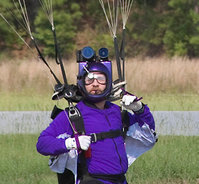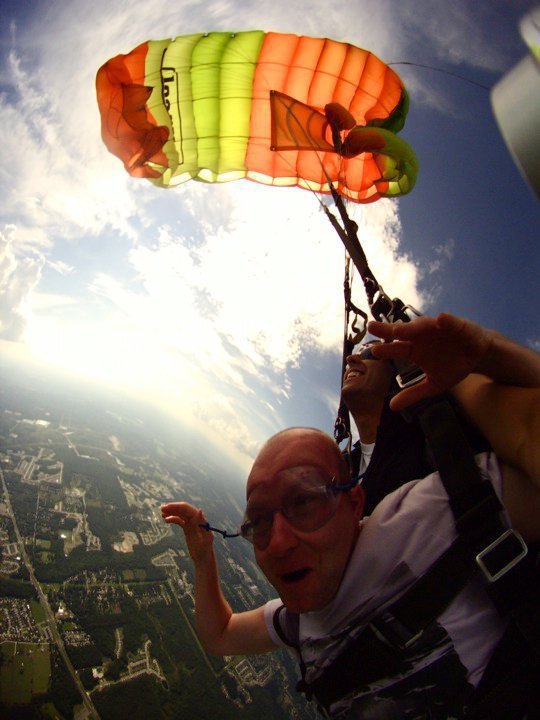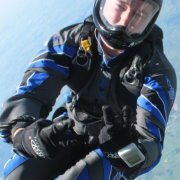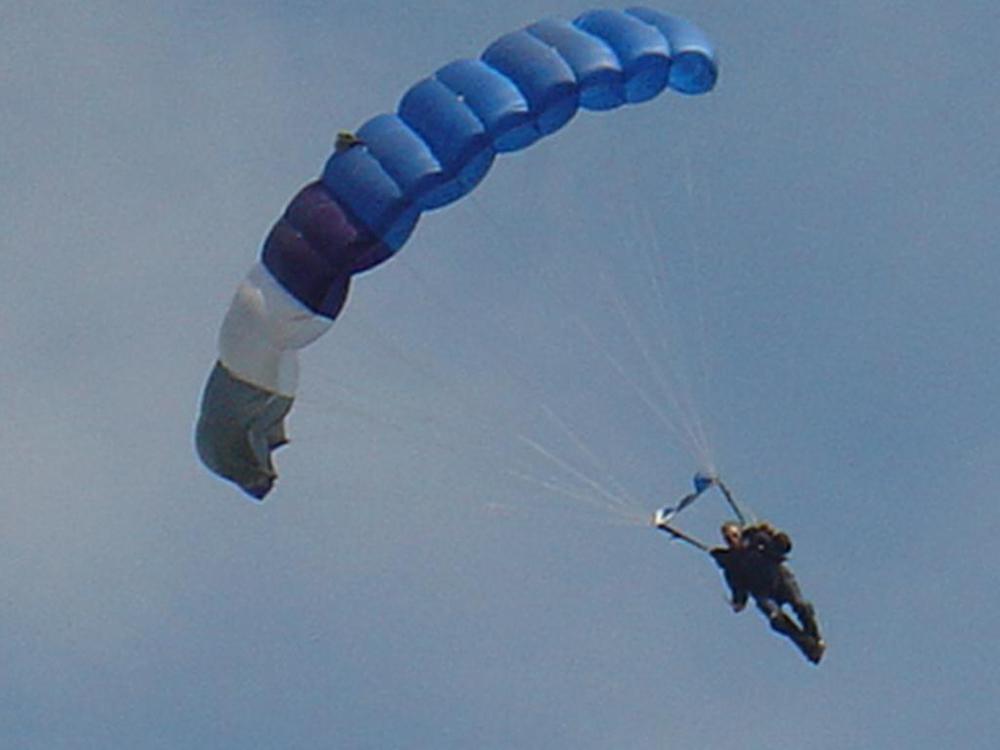QuoteI only know three options:
Put it on your head and secure it, secure it to your chest strap, or secure it to your seatbelt._Am
What is wrong with an additional strap that connects to chest strap and your helmet?
QuoteWhat is wrong with an additional strap that connects to chest strap and your helmet?
Nothing, as long as it is strong enough to hold in a crash. What's wrong with using canned footage for T.O. and alti shots and other "fillers" leaving only the pre jump interview, one or two shots of their face in the plane, the jump, landing, post interview.
I haven't shot a take off in a longtime, I have a number of nice ones I use as canned footage. If I go to a dz where they don't have "house" editing system and I don't haul mine with me, then I might shoot T.O. and do it as I posted above, with my helmet strapped to my chest strap, via the bone or the built in "granny strap" for the video camera and I use the strap of the camera wrapped around my hand so the camera can't go flying free. I don't like to use seat belts to hold the helmet in tightly packed AC's because I don't want others sitting on, bumping, stepping on, my cameras or sight, with it attached to my chest strap by the bone (I do it that way 90% of time) the helmet is upside down with the cameras resting in my lap and I can protect it from the movements of others.
I am jumping an otter, not a KA but I think this should work in most any plane. I do like sitting next to the big door though, for take off and inflight filming alike.
Bill_K 0
Quote
even after I turned around he still wouldn't take off. And when I am facing forward i have more weight forward than if I were sitting down. He (the mediocre pilot) has a problem with me anyway. He would always be bitching about something.
I was not there and on the plane so I won't comment to what happened on the plane... I will remind though, who ever the pilot is that is flying he/she is the PIC.
Per the FAA regulations he/she is in charge from the moment those engines start turning for the purpose of moving that plane with the intent of flying it until they stop turning when the plane is parked back in it's spot. I'm not defending anybody's actions one way or the other, just saying that when we signed the wavers at (insert any DZ here) and get on that plane we are voluntarily placing ourselves under the PIC's direct control and are his/her responsibility until we exit that plane. If something happens it's his/her license that the FAA is going to come after, not mine. I am speaking as both a fellow skydiver and a commercial / CFII here.
BK
I would NEVER put on my camera helmet during the take off.
Imagine what would happen during a crash. That extra pound or two would become lot havier caused by the G forces and my head would be just torn off from my neck.
I don't think to wear a camera helmet on my head during take off is a smart choice... I try to keep my head attached to my body even if the plane crashes.
-Laszlo-
IMHO Holding your helmet/camera without any strap is a bad idea and I have never agreed with that. Even if you are holding your video camera with the hand strap attached. In the event of a crash you would not be able to hold the camera. There has to be some security.
Is there someone here that can figure out the G-forces and how much a camera would weigh in a crash. A 1lb camera would weigh x lbs in a 5G crash etc.
Dokeman 0
quade 4
QuoteOn my head ready to exit. Only take it off after seat belts come off.
The issue I have with wearing the helmet during takeoff is that in a crash scenario, it's more likely that it will snap your neck than save your skull.
Camera helmets are camera HOLDERS, not protective devices.
The World's Most Boring Skydiver
quade 4
QuoteIs there someone here that can figure out the G-forces and how much a camera would weigh in a crash. A 1lb camera would weigh x lbs in a 5G crash etc.
The math is pretty simple; a 10 pound camera helmet will "weigh" 50 pounds in a 5G crash. I certainly would never consider 5G to be the upper limit on a crash though.
The normal aircraft seats are designed to survive up to 9G (crap assed bench seating we typically see in a Twin Otter; your guess is as good as mine says maybe 4G) and the human body may survive up to 20G if aligned normally (which it won't be in a skydiving aircraft accident). Beyond 20G body parts have a tendancy to depart the body.
Wearing your camera helmet in a crash is simply asking for your neck to be broken.
Holding it in your hands is futile and it will smash into someone else.
Securing it with a seat belt is your best option, but the chest strap is a reasonable compromise, in my opinion.
The World's Most Boring Skydiver
QuoteQuoteOn my head ready to exit. Only take it off after seat belts come off.
The issue I have with wearing the helmet during takeoff is that in a crash scenario, it's more likely that it will snap your neck than save your skull.
Camera helmets are camera HOLDERS, not protective devices.
I can agree with that. no need to have 8-10 extra lbs on your head. It's bad enough at deployment time.
QuoteI know the nylon strap your using and it also has a plastic buckle. Now, i think the plastic buckles/ratchet strap addapters are plenty strong enough for the intedned purposes, but I still see that being the weakest part.
The strap could use an upgraded buckle, maybe a RSL and stainless 3 ring piece. But the nylon strap it's self would hold up.
Dokeman 0
Fast 0
QuoteQuoteIs there someone here that can figure out the G-forces and how much a camera would weigh in a crash. A 1lb camera would weigh x lbs in a 5G crash etc.
The math is pretty simple; a 10 pound camera helmet will "weigh" 50 pounds in a 5G crash. I certainly would never consider 5G to be the upper limit on a crash though.
The normal aircraft seats are designed to survive up to 9G (crap assed bench seating we typically see in a Twin Otter; your guess is as good as mine says maybe 4G) and the human body may survive up to 20G if aligned normally (which it won't be in a skydiving aircraft accident). Beyond 20G body parts have a tendancy to depart the body.
Wearing your camera helmet in a crash is simply asking for your neck to be broken.
Holding it in your hands is futile and it will smash into someone else.
Securing it with a seat belt is your best option, but the chest strap is a reasonable compromise, in my opinion.
I agree. I have filmed a couple different take offs with a light plane and my camera attached to a seat belt. Since then I just use all canned takeoffs in my tandem videos and I secure my helmet to my chest strap. I don't like the weight on my neck really at all. I do what I can to not wear the helmet as much as I can. The worst that is going to happen on my chest strap is that the camera bashes me in the face. Thats my risk to take in a crash and I see it as a lesser risk to having my neck tore off.
Where troubles melt like lemon drops Away above the chimney tops That's where you'll find me.
Swooping is taking one last poke at the bear before escaping it's cave - davelepka
Quotewhy not eliminate the buckle and just have a solid strap?
I wouldn't want to undo my chest strap in flight. And attaching it to the seat belt might make it useless.
jimmytavino 16
" is simply asking for your neck to be broken"
![]()
hmmmm valid point, i guess... ![]()
my logic is that the protection ( to myself AND everyone in the cabin) afforded by wearing it...may outweigh the 'risk' of the extra G's...
should a problem come up.....
but now i dunno.....
Not sure what the forces are like when comparing, a slammer opening @ 125 mph.. to a flared emergency aircraft touchdown at 50 60 or 70 MPH.... I've endured many such openings and so far ZERO such landings...
if time exists, to brace for such a landing, however, i think my hands would be solidly ON the helmet, adding some degree ( i hope ) of protection from having my head fall off.....![]()
![]()
What's worse???? that scenario, ( braced for touchdown) or crashing with No head protection at all... AND a helmet flapping around on a chest strap....or harness or seatbelt...
I suppose the size shape and strength of a persons neck, shoulders and arms, may factor in, as well.....some are more solid than others,,,
anyway
thanks for the 'food for thought'...
aw hell...... maybe I'll just leave the cameras on the ground!!!
.. cause now i'm not sure what's the best idea....
will be following this thread. for sure.
thanks all,,, for the thought provoking comments...
j t
a 3914
d 12122






Put it on your head and secure it, secure it to your chest strap, or secure it to your seatbelt.
If someone wants to film a takeoff, as long as their helmet is secure it's ok. Holding your helmet in your hands may very well kill someone.
_Am
You put the fun in "funnel" - craichead.
Share this post
Link to post
Share on other sites